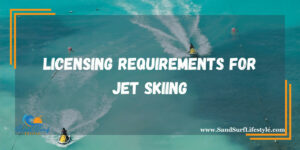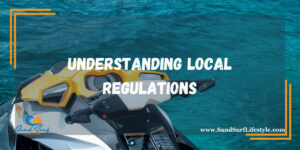Jet skiing is an exhilarating water sport that allows individuals to zip across the waves and experience the thrill of high-speed watercraft. Whether you’re vacationing at a beach destination or considering purchasing your own jet ski, you may wonder about the legal requirements for operating one of these powerful machines. One of the most common questions that arise in this context is whether you need a license to drive a jet ski.
Licensing Requirements for Jet Skiing

1. Personal Watercraft (PWC) Definition
To determine whether you need a license to drive a jet ski, it’s crucial to grasp the legal classifications and terminology associated with these exhilarating watercraft. Jet skis belong to a category known as personal watercraft (PWC), encompassing various vessels like WaveRunners, Sea-Doos, and Jet Skis (the brand name coined by Kawasaki). This classification distinguishes PWCs from larger boats and introduces specific regulations and licensing requirements in many regions.
The term “personal watercraft” highlights the individualized nature of these vessels. Unlike traditional boats, PWCs are typically designed for one to three riders and are known for their agility and speed. Due to their unique characteristics, governing bodies often implement distinct rules and regulations to ensure the safe operation of PWCs, making it imperative for enthusiasts to comprehend the PWC category and its implications on licensing and usage.
2. Age Restrictions
Age restrictions represent a pivotal aspect of jet ski and personal watercraft (PWC) operation, with requirements varying considerably depending on your geographical location. In the United States, for instance, the minimum age for operating a jet ski is commonly set at 16 years old, although this criterion can fluctuate from state to state.
These age restrictions aim to strike a balance between allowing young individuals to enjoy the thrill of jet skiing and ensuring their safety on the water. Some regions might permit younger operators to engage in jet skiing activities but impose certain restrictions, such as requiring supervision by a licensed adult. These supervisory measures are designed to provide an added layer of safety, especially when less-experienced individuals are at the helm of a high-powered PWC. Therefore, it’s crucial to familiarize yourself with the specific age-related regulations in your area to ensure compliance and safety while enjoying the exhilarating world of jet skiing.
3. Boater Education Courses
Boater education courses play a pivotal role in jet skiing and personal watercraft (PWC) operations, particularly in regions where completing such a course is a mandatory requirement. These courses are designed to provide aspiring PWC operators with essential knowledge and skills to navigate waterways safely and responsibly. The curriculum of boater education courses typically encompasses a wide range of topics, including safety regulations, navigation rules, and responsible boating practices.
One of the primary objectives of these courses is to instill a deep understanding of the rules and regulations governing watercraft operations, emphasizing safety as the utmost priority. Participants learn about proper navigation techniques, how to respond to emergency situations, and how to share the water with other boaters and swimmers safely.
These educational initiatives are instrumental in fostering a culture of responsible PWC operation and ensuring that operators are well-prepared to handle the challenges and complexities of waterborne recreation. By completing a boater education course, individuals not only comply with legal requirements but also contribute to the overall safety and harmony of shared waterways.
4. Licensing and Certification
In some states and countries, obtaining a boating license or certification is a prerequisite for legally operating a jet ski or any personal watercraft (PWC). These licenses are typically granted to individuals who have demonstrated a thorough understanding of boating safety rules and regulations through the successful completion of an examination.
The content and requirements of these licensing exams can vary significantly depending on your local jurisdiction. They often encompass a wide array of topics, such as navigational rules, safety protocols, and emergency procedures specific to watercraft. Successful candidates are not only knowledgeable about safe boating practices but are also equipped to make informed decisions on the water.
Obtaining a boating license or certification underscores a commitment to safety and responsible watercraft operation. It ensures that operators have the essential skills and knowledge needed to navigate waterways while minimizing risks and preventing accidents. Therefore, individuals planning to operate a jet ski should diligently research and adhere to the licensing requirements stipulated in their specific region to comply with legal mandates and prioritize safety on the water.
5. Supervision Requirements
In certain regions, there are provisions allowing younger individuals to operate a jet ski under the supervision of an adult, even if they haven’t acquired their own jet ski license or certification. These supervision requirements are implemented to strike a balance between introducing younger individuals to the thrill of jet skiing and ensuring their safety.
Under such rules, inexperienced or underage operators are typically required to be accompanied by a licensed and experienced adult while operating a jet ski. This ensures that those with limited knowledge and skills are guided by someone who understands the nuances of safe jet skiing practices. The supervising adult takes on the responsibility of overseeing the young operator, providing guidance, and intervening in case of any safety concerns or emergencies.
These supervision requirements not only allow younger individuals to enjoy the excitement of jet skiing but also serve as a safety net to prevent accidents and mishaps on the water. It’s essential to be aware of the specific regulations in your area regarding age and supervision to ensure compliance and safety during jet ski outings.
6. Rental and Tour Operations
If you’re planning to rent a jet ski for a thrilling adventure during your vacation or join a guided jet ski tour, you may find that licensing requirements differ from those for personal ownership. In many cases, rental companies and tour operators simplify the process, making it accessible to a broader range of participants.
Rental companies typically offer a brief training session to renters before they hit the water. During this session, participants receive essential safety information, operational instructions, and guidance on adhering to specific waterway rules. While a formal license may not be necessary, compliance with these safety guidelines is crucial.
Jet ski tour operations often follow a similar approach, ensuring that participants are well-informed about safety practices and the operation of the watercraft. Tour guides, who are usually experienced jet ski operators, accompany the group to provide guidance, answer questions, and ensure that participants follow safety protocols.
It’s important to note that while licensing requirements may be simplified for rentals and tours, participants are still expected to prioritize safety and adhere to the guidelines provided by the rental or tour operator. Always inquire about any specific prerequisites or safety measures in place before booking your jet ski adventure to ensure a safe and enjoyable experience.
To learn about the basics of jet ski driving on water, check out this article.
Safety and Responsible Jet Skiing
1. Life Jackets and Personal Flotation Devices (PFDs)
When it comes to jet skiing, safety should always take precedence, regardless of whether you require a license. One of the fundamental safety measures is the use of life jackets or personal flotation devices (PFDs). These safety gear items are often mandatory, and for good reason.
Life jackets and PFDs are specifically designed to keep you afloat in the event of an accident or an unexpected fall into the water. They provide crucial buoyancy, preventing you from sinking and allowing you to stay afloat until help arrives or until you can get back on your jet ski. These devices come in various styles and sizes, ensuring a comfortable fit for all riders.
By wearing a life jacket or PFD, you significantly enhance your chances of survival in the event of an emergency, even if you are a skilled swimmer. It’s a vital piece of equipment that should never be overlooked, serving as a lifeline in potentially life-threatening situations.
2. Speed Limits and No-Wake Zones
Responsible jet skiing includes adhering to speed limits and respecting designated no-wake zones in the waterways you navigate. Speed limits are in place to ensure the safety of everyone sharing the water, including swimmers, boaters, and fellow jet ski enthusiasts.
Speed limits are typically posted and enforced to maintain order and prevent reckless and dangerous operation of personal watercraft. Ignoring these limits can not only result in accidents but also lead to legal consequences.
No-wake zones are areas where watercraft operators are required to operate at a reduced speed, creating minimal wake. These zones are designated to protect the safety of swimmers, wildlife habitats, and shoreline properties. It’s essential to pay attention to signage indicating no-wake zones and slow down accordingly when entering these areas.
By obeying speed limits and respecting no-wake zones, jet ski operators contribute to the safety and tranquility of shared waterways, fostering a harmonious environment for all who enjoy them.
3. Alcohol and Drug Regulations
Operating a jet ski while under the influence of alcohol or drugs is not only dangerous but also illegal in most places. Boating while impaired can impair your judgment, reaction time, and coordination, significantly increasing the risk of accidents and collisions.
Alcohol and drugs can also affect your perception of your surroundings, making it difficult to navigate safely and respond to changing conditions on the water. Law enforcement agencies actively patrol waterways to enforce these regulations, and violations can lead to severe legal consequences, including fines, license suspension, or even imprisonment.
To ensure your safety and the safety of others, it’s imperative to adhere to alcohol and drug regulations when operating a jet ski. If you plan to consume alcohol or substances, designate a sober operator or wait until you’re safely ashore.
4. Environmental Responsibility
Responsible jet skiing extends beyond safety measures and includes protecting the natural environment. Being an environmentally conscious jet ski enthusiast involves respecting the delicate balance of aquatic ecosystems and minimizing your impact on the environment.
Avoid disturbing wildlife, such as nesting birds or marine mammals, by keeping a safe distance. Stay away from sensitive habitats, like seagrass beds and coral reefs, which are crucial to marine life. Dispose of any trash or waste properly, either by bringing it back to shore or using designated waste disposal facilities.
By practicing environmental responsibility, you help preserve the natural beauty of waterways, ensuring they remain pristine for future generations to enjoy. Additionally, respecting the environment reflects positively on the jet skiing community, promoting a harmonious coexistence with nature.
Understanding Local Regulations

It’s crucial to note that the regulations and licensing requirements for jet skiing can vary significantly depending on your location. Different countries, states, and municipalities may have their own rules and enforcement mechanisms. To ensure you comply with local laws and stay safe while enjoying your jet ski, consider the following steps:
1. Research Local Laws
Before embarking on a jet ski adventure, it’s paramount to research the specific regulations that govern jet ski operations in your area. This essential step ensures that you remain compliant with local laws and can enjoy your watercraft responsibly. Information regarding these regulations can typically be found on government websites dedicated to boating and watercraft or obtained by reaching out to local authorities. Familiarizing yourself with these rules helps you avoid legal complications and ensures that you’re aware of any unique requirements or restrictions in your region.
2. Consult Rental Agencies
If you’re planning to rent a jet ski, it’s wise to consult the rental agency regarding licensing or certification prerequisites. Rental companies are well-versed in local laws and regulations governing jet ski operations. They can provide valuable guidance, ensuring you have the necessary credentials and understand any specific safety guidelines they have in place. Engaging with rental agencies allows you to rent and operate a jet ski with confidence, knowing that you’re within the bounds of local laws and that the rental experience is both enjoyable and safe.
3. Take a Boater Education Course
While not always mandatory, enrolling in a boater education course, even in jurisdictions where it’s not required, can significantly enhance your safety knowledge and watercraft operating skills. These courses cover vital aspects of boating safety, navigation rules, and emergency procedures, ensuring you’re well-prepared for various scenarios. Completing a boater education course not only contributes to your safety but also reflects a commitment to responsible and informed jet skiing. It’s an investment in your skills and knowledge that can enhance your overall jet ski experience.
4. Practice Safe Boating
Regardless of licensing requirements, your top priority when operating a jet ski should always be safety. This means wearing the appropriate safety gear, including life jackets or personal flotation devices (PFDs), adhering to posted speed limits and avoiding reckless behavior on the water. By practicing safe boating habits, you minimize risks not only to yourself but also to others sharing the water. Responsible jet skiing ensures that you can enjoy this thrilling activity while maintaining a high level of safety and minimizing the potential for accidents or mishaps.
To learn how fast jet skis go, check out this article.
Conclusion
So, do you need a license to drive a jet ski? The answer depends on your location and age, as well as the specific regulations in place. While some areas may require licenses, others may only mandate a minimum age and boater education courses. Regardless of the legal requirements, responsible and safe jet skiing should always be your priority. Educate yourself on local regulations, take safety precautions seriously, and enjoy the thrill of jet skiing while respecting the environment and the safety of yourself and others on the water. By doing so, you can make the most of this exciting water sport while staying within the bounds of the law.
Please note that the contents of this blog are for informational and entertainment purposes only and should not be construed as legal advice. Any action taken based on the information provided in this blog is solely at your own risk. Additionally, all images used in this blog are generated under the CC0 license of Creative Commons, which means they are free to use for any purpose without attribution.

